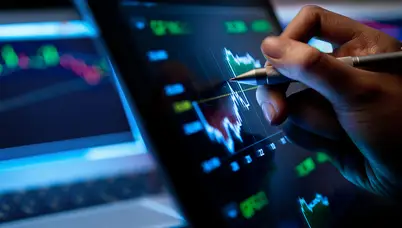Will Gold continue to shine in 2009?
Posted On Sunday, Feb 01, 2009
2008 proved to be a “Year of Safety”. Two G’s representing safe assets i.e. Gold and Government Bonds emerged as clear winners in times of turmoil. Gold as an asset class has been proving year over year that this under owned asset surely deserves a place in each investor’s portfolio. In dollar terms, gold prices increased for eighth consecutive year with gains of 5% in 2008. For the Indian Investor, gold has provided positive returns for 11 consecutive years with gains of 29% in 2008.
Chart I : Returns from Gold

Source: Bloomberg
In early 2008, we saw gold prices rally to all time record highs above $1000. This rally in gold was multi factor driven viz., inflation fears as oil and other commodity prices escalated towards record highs, Geopolitical concerns, and the biggest of all the unfolding of the sub prime debacle in the U.S with the Bear Stearns collapse; leading to economic and financial upheaval; this encouraged safe haven buying in Gold.
As events unfolded, prices displayed more volatility. Technical driven sell calls and profit booking led to a correction in Gold prices. However, the correction short-lived as growing fears of systemic risk in the financial sector along with rising inflationary expectations, dollar weakness and heightened geopolitical tensions helped gold inch higher. One by- one, mega financial institutions found difficult to survive. Stock markets collapsed globally, Interbank lending freezed - a perfect recipe for a financial disaster. Investors rushed for the cover of traditional safe-haven assets like government bonds and gold.
Even with the safe haven demand and heightened uncertainty, it caught many by surprise that gold prices could not even surpass the previous highs reached earlier this year. This led to questions being raised on gold’s “safe haven” status.
The fundamental question remains as to why did gold decline even when all the positive factors for a gold rally were in place?
A financial tsunami does not differentiate between good and bad, it takes away everything with it. As global assets plummeted, Gold as an “asset of last resort” was sold to meet margin calls due to heavy losses on other investments. Heavy hedge fund selling in order to meet redemption pressures also led to the decline. Worldwide recession fears led to unwinding of commodity index investments which included gold; this led to more selling. Strong appreciation of the U.S dollar as it gained ground as a safe haven after the crisis showed signs of spreading globally; triggered unwinding of long gold / short dollar trades. This led to more outflows from gold. All this clearly explains gold’s underperformance even during such uncertain times. Investors hungry for liquidity sold gold, as it was the only asset doing well.
Chart II : Gold in 2008

Source: Bloomberg
As selling pressure eased, gold prices jumped on the back of strong physical offtake. Investors, in order to safeguard their wealth, increasingly turned towards gold leading to physical supply shortages in key consuming areas. Although with increased volatility, gold kept inching higher. Gold prices ended the year with positive returns at a time when other assets were badly hit underpinning its role as an effective portfolio diversifier.
Going forward, we expect gold prices to continue its upward journey. The macro economic and supply demand factors are supportive of higher prices. The uncertainty that surrounds the global economy would continue to underpin gold’s role as a safe haven. There is an increasing likelihood that global deflationary scenario would change to an inflationary one as central banks globally pump in money created out of thin air; leading to a rally in gold prices. Geopolitical concerns have just been sidelined and not over yet. There are various issues in different corners of the globe like the Israel Hamas conflict, Indo - Pak war on terror, Iran’s nuclear imbroglio; any of these might flare its head up and lead to increased tensions. Gold works as an effective hedge against rising inflation and geopolitical concerns.
The financial crisis has been deeply rooted in the U.S. and its central bank has been the forerunner to pump in dollars to bail out financial institutions and banks in order to help its economy on its feet. This increased money supply without any real asset backing it, would eventually lead to debasement of the dollar. The dollar would continue to depreciate as it has since the start of this decade and help gold prices increase. Gold and Dollar tend to move in opposite direction to each other over the long term.
On the Fundamental side, supply demand factors continue to indicate a tight market. Demand has been continuously rising whereas supply just hasn’t kept pace even with prices quadrupling.
On the supply side, Mine supply has been declining year on year, no major discoveries inspite of increasing exploration expenditure and increasing mining challenges along with high costs continues to signal fresh supply tightness. Central banks sales have been declining significantly.
On the demand front, traditional buyers in key consuming countries are always ready to buy at any price declines providing a rising and well defended floor price. The investment community is more and more turning towards gold as a safe haven investment and given its excellent diversification properties as well as stellar performance in last few years. More and more innovative vehicles of investments like Gold ETFs, Structured and capital protected notes are making it convenient for investors to gain exposure to the precious metal.
All in all, demand supply dynamics points towards continuation of a deficit market indicating further increases in prices.
Keep on buying Gold in demat form, as a hedge, just in case, your call on traditional asset classes like equities goes wrong. Gold will continue to minimize your losses as its has done in past several years including 2008. Also, the macro economic and supply demand fundamental factors are supportive of higher prices. Hence, Investors can have a higher allocation to Gold.
Table I: Quantum Gold ETF v/s Physical Gold (For information purpose only)
| No. | Criteria | Physical Gold (From Jeweller) | Quantum Gold ETF (Gold in Demat form) |
| 1 | Purity of Gold | Unsure; can be adulterated | Sure; 0.995 purity Gold |
| 2 | Availability of Standard Pricing | No; may differ from jeweller to jeweller | Yes; linked to International Gold prices |
| 3 | Premium paid over gold price | High; making charges and profit margins included | No premium over standard price of Gold |
| 4 | Convenience | Low; Physical movement and transfer is involved | High; the assets are held in a demat account |
| 5 | Storage Requirements | High, as it is in physical form; locker or safe | Low; for the investor, it is stored in a demat account |
| 6 | Security of the asset | Investor is responsible | Fund house takes care of this |
| 7 | Resale Value | At a high discount; making charges are deducted again | Easily traded on the NSE at a value close to the prevailing price of gold. |
| 8 | Wealth Tax | Yes | No |
| 9 | Long Term Capital Gains Tax | After 3 years | After 1 year |
*Please consult a Tax Advisor for specific Tax implications.
Related Posts
-

Debt Monthly View for January 2025
Posted On Friday, Feb 07, 2025
Bond markets witnessed increased volatility during the last month with the 10-year Government
Read More -

Gold Monthly View for January 2025
Posted On Friday, Feb 07, 2025
In the calendar year 2024, gold demonstrated remarkable performance, yielding a return of ~ 27%.
Read More -

Equity Monthly View for February 2025
Posted On Thursday, Feb 06, 2025
Indian markets witnessed sharp sell-off in the month of January on the back of continued FII selling (USD -8.6Bn in January 25 vs USD -755Mn for CY2024).
Read More




